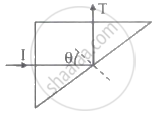Advertisements
Advertisements
प्रश्न
An infinitely long cylinder of radius R is made of an unusual exotic material with refractive index –1 (Figure). The cylinder is placed between two planes whose normals are along the y direction. The center of the cylinder O lies along the y-axis. A narrow laser beam is directed along the y direction from the lower plate. The laser source is at a horizontal distance x from the diameter in the y direction. Find the range of x such that light emitted from the lower plane does not reach the upper plane.
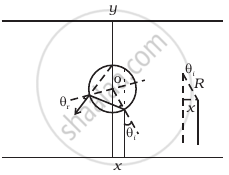
उत्तर
Here the material has refractive index – 1, θr is negative and `θ_r^'` positive.
Now, `|θ_i| = |θ_r| = |θ_r^'|`
The total deviation of the outcoming ray from the incoming ray is 4θt. Rays shall not reach the receiving plate if `pi/4 ≤ 4θ_i ≤ (3pi)/2` [angles measured clockwise from the yiaxis]
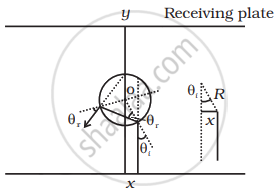
On solving, `pi/8 ≤ θ_i ≤ (3pi)/8`
Now, `sin θ_i = x/R`
`pi/8 ≤ sin^-1 x/R ≤ (3pi)/8` or `pi/8 ≤ x/R ≤ (3pi)/8`
Thus for light emitted from the source shall not reach the receiving plane if `(Rpi)/2 ≤ x ≤ (3Rpi)/8`.
APPEARS IN
संबंधित प्रश्न
A ray of light passing from air through an equilateral glass prism undergoes minimum deviation when the angle of incidence is 3/4 th of the angle of prism. Calculate the speed of light in the prism.
Find the angle of incidence at face AB so that the emergent ray grazes along the face AC.
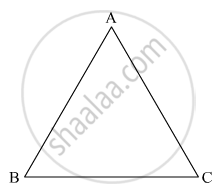
Trace the path of the ray (P) of light passing through the glass prism as shown in the figure. The prism is made of glass with critical angle ic = 41°.
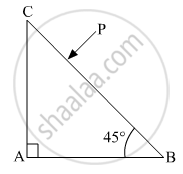
Three light rays red (R), green (G) and blue (B) are incident on a right angled prism ‘abc’ at face ‘ab’. The refractive indices of the material of the prism for red, green and blue wavelengths are 1.39, 1.44 and 1.47 respectively. Out of the three which colour ray will emerge out of face ‘ac’? Justify your answer. Trace the path of these rays after passing through face ‘ab’.
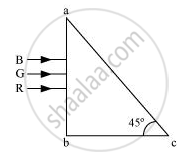
Suggest a method to produce a rainbow in your house.
Find the angle of minimum deviation for an equilateral prism made of a material of refractive index 1.732. What is the angle of incidence for this deviation?
A ray PQ is incident normally on the face AB of a triangular prism of refracting angle 60° as shown in figure. The prism is made of a transparent material of refractive index `2/sqrt(3)`. Trace the path of the ray as it passes through the prism. Calculate the angle of emergence and the angle of deviation.
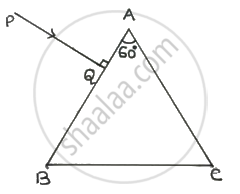
A horizontal ray of light passes through a prism of index 1.50 and apex angle 4° and then strikes a vertical mirror, as shown in the figure (a). Through what angle must the mirror be rotated if after reflection the ray is to be horizontal?
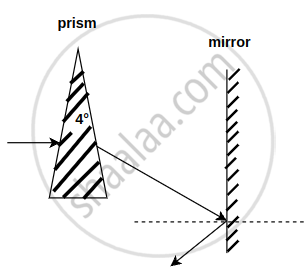
The maximum value of the index of refraction of a material of a prism which allows the passage of light through it when the refracting angle of the prism is A is ______.
A triangular prism of glass is shown in the figure. A ray incident normally to one face is totally internally reflected. If θ is 45°, then the index of refraction of the glass is ______.
